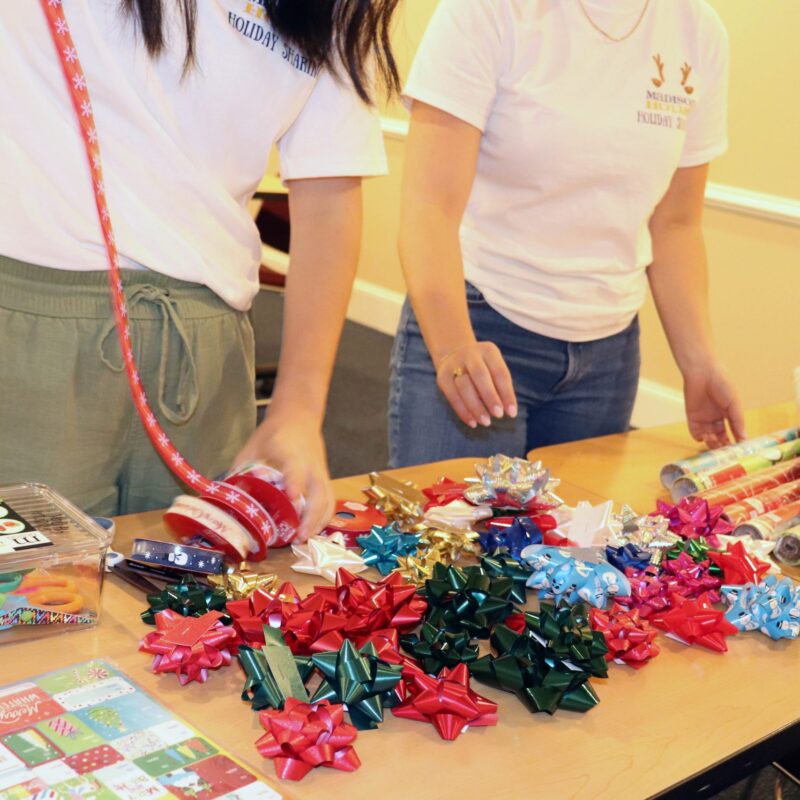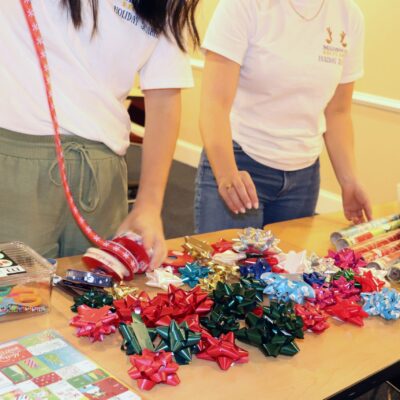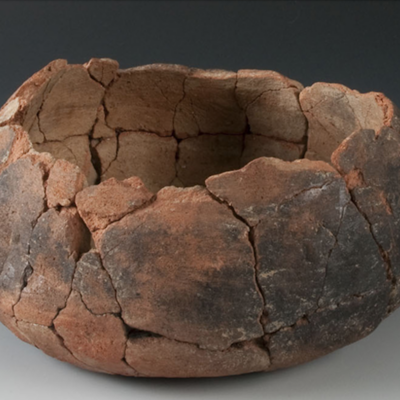In the world of athletics, it’s often the coaches and players who receive the most recognition. They are, after all, the stars on the court or field or in the pool, the ones who are directing the flow of the competitions, making the winning shots or jumping further than their opponents. But they didn’t reach the top by themselves. Behind them on a daily basis is a strong support staff made up of assistant coaches, academic advisors, doctors, athletic trainers and equipment managers, to name a few. Meet five of these behind-the-scenes team members who are currently assisting the University of Virginia’s coaches and helping its student-athletes excel both on and off the field.
Chris Moore
Equipment manager, men’s baseball, softball, track and field, women’s soccer and volleyball
The black desk phone rings: It’s Rawlings again. UVA Athletics equipment manager Chris Moore already spent an hour on the phone with Rawlings employees earlier in the day, finalizing plans for new gray uniforms for the baseball team. The uniforms will be more traditional as opposed to the throwback style players are wearing now. And in about a month the team will switch to a new cream-colored uniform. Moore generally gets two to three calls a day from Rawlings, which he works with on not only designing new uniforms but in helping the company tweak new equipment for UVA’s baseball players to use.
The company approaches UVA, its No. 1 advisory school, with an idea of what it wants to make, then the student-athletes wear-test the equipment in the fall (the final products are issued in the spring). Student-athletes fill out forms electronically to give feedback about each product they test, and Rawlings follows up with Moore to get his overarching opinion. In the past year Moore flew to Japan twice to work with Rawlings on developing new batting gloves and bats.
“From the handle on the grip of a bat to the leather on the palms of batting gloves, it’s good to get our players’ feedback since we’re one of the top programs in the nation,” Moore says. “That way they have a sense of, ‘I helped create that.’ They can’t say, ‘This bat is bad,’ because they helped create that for two months.”
Another job perk other than flying to new countries is traveling with the teams to road games, meets and matches. Moore was in the dugout last year when the baseball team won its first national championship. He said the experience was unbelievable and that the win is still sinking in in a way—after all, there was plenty of work to do once they returned. During baseball season he estimates he works 60 to 70 hours a week between practices, games and everyday duties.
Reminders of Moore’s contributions to the baseball team’s success line a shelf above his desk: a glove Rawlings gave him after the baseball team won the championship and a jewelry stand hand wearing four rings: the largest being the national championship ring.
But baseball isn’t Moore’s only focus. He oversees the equipment and practice and game uniforms for about 250 student-athletes. He stays organized with multiple spreadsheets that track everything from what bat a baseball player is currently using, shoe sizes, jersey and T-shirt sizes (often different) down to which players prefer elastic waistbands in their pants. Moore also devised a labeling system with adhesive stickers on the back of sneakers. The stickers correspond to an athlete’s locker number, so if shoes are left on the field they can be returned. He estimates the track team goes through 500 to 600 pairs of shoes a season. One distance runner can need up to six pairs alone. In the matter of an hour three students stop by Moore’s office: one needs a new shorts size, another asks about getting a different kind of sock and the third wants the sports bra cut out of her singlet. Oftentimes he answers the student-athletes’ questions before they even ask—he can anticipate their needs.
The best part of Moore’s job are the relationships he develops with the players. He loves seeing them grow from 18-year-olds into strong student-athletes. His role is that of a parent or role model, he says, and he keeps in contact with a lot of them after they graduate.
“My biggest thing is that you treat others with respect and you just show these kids the right way to do things and how enjoyable college life can be as a student and an athlete, because they’re never going to get this time back,” he says. “They have four years to excel in the classroom and on the field and, hopefully, win a national championship. As a staff member it’s so gratifying to see that they’ve reached the top level, and they’ll always have that memory.”
Randy Bird
Director of sports nutrition for all UVA teams

Randy Bird, director of sports nutrition for UVA teams, says athletes need to eat a meal or snack every three to four hours to provide the fuel their bodies need for recovery. Photo: Amy Jackson
How did your position as the team nutritionist begin? How long have you held the position?
I accepted the position of director of sports nutrition at UVA in August of 2010. Prior to UVA, I was the sports dietitian at the University of Kansas.
What are some of the more important habits/knowledge you’ve tried to instill in the players?
Food is their fuel. They need to put the best fuel possible into their body. Athletes need to eat a meal or snack every three to four hours to provide the fuel their muscles need and the building blocks necessary for recovery. Athletes need to eat fruits and vegetables on a daily basis. The more stress athletes are under, the more produce they need. In addition, protein should be spaced out multiple times per day (preferably in four or five doses of protein-rich foods).
What are some common mistakes that you see athletes make in their diets?
Skipping breakfast. Inadequate consumption of fruits and vegetables. Inadequate fluid intake. Recovery after training and competition is not taken seriously.
What are some things you look for when conducting an athlete’s nutrition assessment that can make an immediate impact on performance, health or recovery?
The primary factors I evaluate are normal hydration habits and total energy intake. Performance and health can be compromised if the athlete’s activity does not match the primary factors. Hydration affects performance quickly, so that is one of the first things I evaluate. If athletes under fuel during the day, they tend to overeat at night. This leads to decreased muscle recovery and increased fat storage.
Are food sensitivities something you are evaluating more often with athletes?
This is definitely an area that is getting more attention. As athletes are diagnosed with intolerances, we devise a plan to properly fuel the athlete and meet their micronutrient needs while avoiding problem foods.
How would you like things to continue to develop in the future in terms of what players put in their bodies?
I really like how athletes are becoming more food-focused. Athletes shouldn’t worry about what supplement to take until they have built their foundation on the right food and hydration strategies.
How can non-athletes embrace your ideas to live healthier lifestyles?
Realistically, everyone should be eating the same types of foods. The general public just needs less of it. Most are marginally active when compared to our athletes. So, the general public doesn’t need to consume the total number of calories that our athletes consume. However, the general public should focus on the types of food athletes eat and the patterns should be the same.
Blair Moore
Athletic trainer, women’s lacrosse

Blair Moore, with women’s lacrosse, says athletic trainers become moms away from home for the student-athletes. She’s on call 24/7 to help the players. Photo: Amy Jackson
No matter how talented a student-athlete is, injuries at the collegiate level are common. In her 12th year as the athletic trainer for the UVA women’s lacrosse team, Blair Moore most often sees ankle sprains, ACL tears and hamstring and quad strains.
“I’ve always loved sports, however, I’m not very talented,” she says. “So I knew I always wanted to do something that kept me close to athletics.”
Moore is in charge of injury prevention and rehabilitation treatment for the team, taking care of anything from a sore throat to a concussion. Practice days, which eat up a lot of Moore’s time, are when she takes care of details that never cross most fans’ minds.
“Starting at 1, we start getting girls ready for practice,” Moore says. “That means taping ankles, getting girls heat if they need it, stretching with them, getting them warmed up before practice. Then we practice for a few hours and then we’ll come back and it’s ice tubs, more stretching out, dealing with any injuries that came up in practice.”
Moore notes that in addition to these responsibilities, she is on call 24/7 for her student-athletes and accompanies them to the doctor or the emergency room at any hour.
“It is very rare, but probably two months ago I had a girl call me at 10pm with severe abdominal pain and we talked through it, and I asked her what she ate and when the pain started,” Moore says. “I called a general practice doctor and talked it through with him, called her back and talked to her again until the pain started to subside. We’re still the person that they call, whether it’s athletic or not.”
Moore jokes the athletic trainers take the place of “moms away from home,” overseeing every aspect of the athletes’ health.
“I talk to our nutritionist probably every day about food for a student-athlete,” she says. “If a student-athlete gets injured, I’m calling over to the academics office to make sure that they can get in touch with faculty in the classroom. …Even in just the equipment room, we’re talking with them about helmet fit.”
Although injuries are never a desirable outcome for a student-athlete, Moore says that helping a student rehabilitate after an injury is the most satisfying part of her work.
“There’s always some doubt in the students: Will I be able to go back? Will I be as good?” Moore says. “And to see the will in some of these student-athletes to face that adversity and overcome it is really rewarding, and that’s why I continue to do it. Seeing someone get back to play and be sometimes even faster or stronger than before is incredible.”
Adam Brooks
Assistant director of academic affairs, men’s tennis

Adam Brooks, assistant director of academic affairs for men’s tennis, says staff’s first priority is not winning championships but helping develop players for the future and where they want to go in life. Photo: Amy Jackson
In the world of college sports, it’s often easy to forget about the student in student-athlete. With multiple practices and games every week, it can be hard to imagine these young athletes also strive to excel in the classroom. But Adam Brooks, the assistant director of academic affairs for the Virginia men’s tennis team, knows full well how much academics factors into these students’ lives.
Growing up with a father who coached Division III football and baseball at Bluffton University, Brooks knew he wanted to stay involved in the world of college sports. After obtaining a teaching license and completing graduate school at the University of Akron, Brooks started work at the University of Virginia in 2009 with men’s tennis.
“I was kind of thinking of how I could blend these two fields,” Brooks says of the job search. “Education and sports, how can I put those together? And this seemed like a perfect fit.”
Despite the backseat that academics seems to take in college athletics, Brooks says the men’s tennis program at UVA is “all in.” When the team lost its first ACC match in almost 10 years February 15, breaking a 140 consecutive game-winning streak, the entire tennis staff discussed the loss at its regular 6:30am Tuesday meeting.
“I think it makes an academic coordinator feel important to be included in those conversations,” Brooks says. “For me, personally, it helps to hear the trainer talk about how a certain student is doing on the court because if he gets injured then I can know how that’s going to affect him academically. We all really want to know what’s going on with every aspect of a student-athlete’s life.”
Brooks’ main responsibility is to ensure that the men’s tennis players meet the eligibility requirements of the NCAA, such as minimum GPA benchmarks, but he stresses that the department’s goal is much higher than the minimum.
“Our own office goals are much more than graduation and much more than eligibility, and that’s definitely a benefit to working with the men’s tennis program,” Brooks says. “Our first priority is not winning championships, but developing these guys for life. We want to make sure that they know who they want to be and where they want to go in life.”
The NCAA requires an athlete to have a 1.8, 1.9 and 2.0 GPA by the end of their first, second and third years respectively. In addition to these benchmarks, athletes are also required to meet UVA’s graduation requirements, which include completing 120 credits and a major.
Although Brooks meets with many players weekly to make sure they are on track for graduation, he notes that head coach Brian Boland keeps the team highly self-motivated.
“Tennis had the highest men’s team GPA this past year [3.37] when they also won the national championship, and they also had the highest GPA in the athletics department that year,” Brooks says. “These guys are getting it done and that’s Boland—he’s not going to be okay with a guy who’s striving for eligibility requirements, someone who’s barely meeting a 2.0.”
With a high-achieving group, Brooks says he focuses more on getting to know his student-athletes and counseling them on how to approach issues in the classroom. Among other things, Brooks sets up organizational calendars with first-year students, holds mock office hours for students who are not sure how to approach a professor and helps students identify classes that interest them.
“I found a position at one of the best universities and towns in the country and one of the best tennis institutions in the country,” Brooks says. “The culture and the staff…we’re all of one mindset, and it makes it such a great culture to be a part of.”
Henrik Wiersholm
UVA men’s tennis player
An average day for Henrik Wiersholm looks like this: eat, sleep, tennis, repeat. As a second-year on the Virginia men’s tennis team, he has two practices a day and often travels for matches on the weekend.
He is usually out of the house by 8am and doesn’t get back until 12 hours later, when he finally gets started on his homework. If he’s lucky, he might squeeze in some time to hang out with friends.
His days on the road, though, are even longer—he often doesn’t eat dinner until 9:30 or 10pm. You won’t hear Wiersholm complaining about his busy schedule, though.
“I think that there’s a structure to what we do that makes it so that there’s not any time to procrastinate, you know?” Wiersholm says about his allocated homework time. “You have to put in the work. …Other students, when they don’t have that structure that a student-athlete has, they’ve got all sorts of time to do their homework and then it becomes a little bit different.”
Although Wiersholm admits that finding time for homework can be tough, he wouldn’t change anything.
“I love team practice,” Wiersholm says. “We come out, play points, compete against each other and, I mean, I love competing, so that’s the part of tennis that I like the most and the part of my day that I like the most.”
Daily schedule
7am: wake up
8 or 9am: individual practice
10am–3pm: class
3:30-6:30pm: team practice
and workout
7pm: eat dinner
8pm: start homework
11pm: go to sleep
Dr. John MacKnight
Professor of internal medicine and orthopedic surgery, primary care team physician and medical director of UVA sports medicine

Dr. John MacKnight, primary care team physician and medical director of UVA sports medicine, says one way they get injured student-athletes back in competition quickly is by working with them multiple times per day, so players derive the benefits of aggressive injury management and physical therapy from the moment they are hurt. Photo: UVA
How do you keep athletes healthy/get them back playing after an injury?
From a health standpoint, we focus on lots of preventive strategies. Great sleep quality, adequate hydration, well balanced, energy-rich diet. Adequate preparation physically involves consistent, well-devised training routines that ensure adequate strength, flexibility, balance and stamina to accomplish their athletic goals. No question that optimizing those parameters not only helps to prevent injury but speeds return from injury.
Are there any innovations used here?
The realm of strength and conditioning and injury prevention is always evolving and there are myriad theories about how best to accomplish those things. Core stabilization activities and a focus on functional muscle development that is unique for each sport (as opposed to just making everyone big) are really big concepts right now that clearly work for most athletes.
How do you get them back on the field/court so quickly?
We have the ability to see and work with our athletes multiple times per day, so they derive the benefits from aggressive injury management and physical therapy essentially right from the time they are hurt. Although some injuries require a fixed amount of time to resolve, regardless of what we do for them, many lesser injuries can be handled more quickly and can result in a more rapid return to sport without compromising the health and safety of the athlete.
What’s the first thing you do when assessing a player?
The first assessment is always about severity of illness or injury. Does this athlete have any features that make their presentation a true emergency? In the absence of that, which would warrant immediate intervention and transport to the hospital, I take a systematic approach to the history of the injury or illness, perform a focused physical exam of the affected area and decide upon immediate management as well as the athlete’s suitability to continue sport on that day.
You oversee all student-athletes on UVA’s 25 teams. Is there a player’s recovery story that stands out to you?
Two stand out this season. [UVA men’s basketball guard] London Perrantes’ return from appendicitis and [UVA football wide receiver] T.J. Thorpe’s return from a broken clavicle. Both are testaments to great care by my surgical and orthopedic colleagues and to the improvements in surgical techniques, which have allowed for far faster recovery times than in the past.
How many doctors assist a team?
We have an extensive staff of physicians who care for our athletes. It really does take a team of physicians to meet all of the needs of the student-athlete population. At UVA we have three primary care sports medicine physicians, four sports medicine-oriented orthopedic surgeons, subspecialty orthopedic surgeons, a team cardiologist and a host of other specialists who help us meet the varied demands of our athletic population. On game day, there are generally three to five physicians present to provide game management.
What is your area of specialty when you’re not with the teams?
I am a general internist and see primary care internal medicine patients in a separate clinic at the Fontaine Research Park.
–Sherry Brown, Jessica Luck and Cara Salpini





